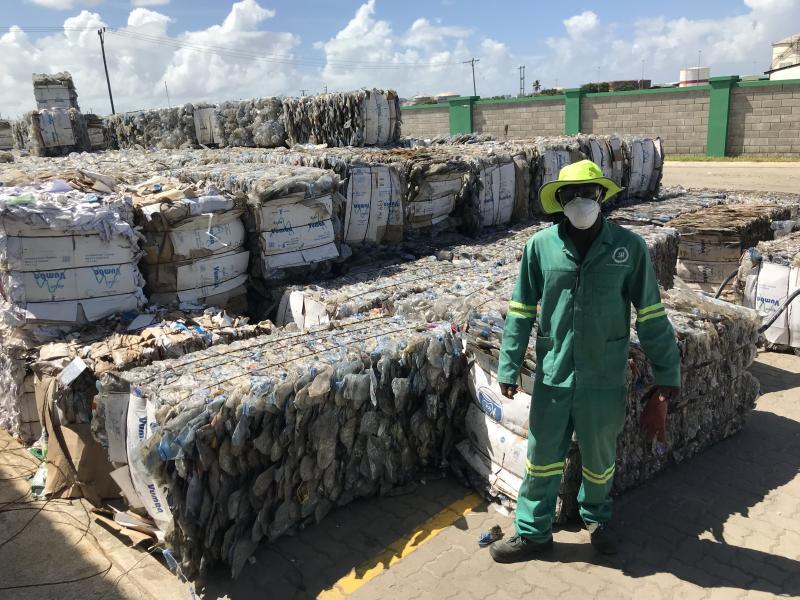Fast-growing urban populations mean more and more waste going to uncontrolled landfills, making waste management a major challenge of our time. Now, a program catalysed by NCF funding is transforming Mozambique’s waste sector, promoting a new circular economy and environmental health, while helping the government deliver on Paris climate promises.
In 2015, a Mozambican recycling company called 3R – Reduzir, Reusar e Reciclar received a grant from NCF. This was with the goal of increasing the amount of municipal waste being recycled and sustainably treated in Mozambique. The EUR 500,000 grant was used for the double purpose of: 1. Working with government and consulting partners to develop a proposal to the Nationally Appropriate Mitigation Action (NAMA) Facility to promote waste recycling in Mozambique and 2. Creating a pilot Material Recovery Facility to test viable business models for recycling.
The catalytic impact of the project has been transformational for the entire country of Mozambique. During the past five years, not only was the proposal to the NAMA Facility approved, bringing the promise of an additional EUR 18 million and financial leverage to the sector, but new waste regulations were approved and the political will towards a circular economy became front page national news. The waste management sector will be radically changed in the coming years, bringing down greenhouse gas production and promoting the circular economy.
More people more waste
National Director for the Environment in the Mozambique Government, Guilhermina Amurane, frames the problem in the context of her country’s growing population and urban migration, noting that in the last 30 years, Mozambique’s population has grown by 10 million people, with an increasing number moving to the cities.
“More people, means more waste,” affirms Amurane, “as well as increasing the threat of environmental and human health impacts.”
“In the current base scenario there are almost zero measures in place. Waste is either not collected or goes into open dump sites,” says Adriaan Tas, Director Carbon Africa, a Kenyan Climate Finance Advisory and main shareholder of the NDF investee 3R. According to official numbers, more than 99% of waste collected in Mozambique is disposed of at uncontrolled dumpsites.
At these sites, large numbers of waste pickers, including children, participate in the informal economy, sifting through waste for any saleable material to support their livelihoods. In addition to hazardous waste exposure and the risk of spontaneous methane fires, in a recent tragic incident in the capital, the collapse of mountains of garbage in an open dumpsite, Hulene, led to casualties and some deaths.
NCF support invaluable
But all this is now set to change. “While the NAMA Facility project is still ongoing,” Amurane stresses, “we have now reached the final stage known as DPP, or detailed preparation phase.”
The ambitious goal of the project is to develop 10 integrated waste infrastructure sites across Mozambique, each having a three-pronged approach to waste management and collection: material recovery, composting, and sanitary landfill, including methane recapture.
Amurane cites the original funding in 2015 as instrumental in getting the NAMA proposal to the level it is at today. “We’ve really been able to improve it and evolve it along the way thanks to the initial support of the NCF grant.” While the initial proposal at that time did not succeed, we understood the process better and came to a second submission better prepared,” she says. The result was that Mozambique was selected from among 70 other competing projects around the world and Amurane is now confident of success and ready to start implementation soon.
This confidence can be underscored by a significant buy-in across the Mozambican government.
“The Mozambican government has been really stepping up,” Tas confirms, citing a considerable number of meetings with government representatives on every aspect of the project that his team has attended. And Tas sees this strong government ownership as a key success factor so far.
Project has wings
“Even in the unlikely event that the NAMA Facility proposal would not go through, the project has already been gaining support at the highest levels,” says Tania Paco, Chief Project Manager at the National Fund for Sustainable Development (FNDS), whose agency, among other responsibilities, will be receiving the funds from the Government and disbursing them under the financial mechanism designed for the project. Just two months ago, Mozambique President Filipe Nyusi elevated the project to a Presidential Initiative. “Certainly, we see this presidential approval as an important step in ensuring the overall long-term success of our goals,” Paco says.
Also important, is the country’s demonstrated ability to leverage the EUR 18 million fund being provided by the NAMA Facility. “This is the number one lesson we’ve learned along the way,” Paco says, “that international climate funds like the NAMA are putting a high value on national and international co-financing potential.”
Leveraging for success
Co-financing already identified by the project includes a sizeable boost from an Extended Producer Responsibility (EPR) tax on packaging, currently slated to come on stream in 2021. The EPR tax will require large-scale manufacturers to take increased financial responsibility for what happens to packaging like cardboard, PET bottles and aluminium cans, and will be based on production numbers.
According to Amurane, over a five-year period, an estimated USD 20 million of upcoming tax will be earmarked to support the project. Additionally, the Mozambique government has also committed USD 10 million in co-financing from its own central government budget and will be exploring other options to leverage funds from future private-sector partners as well as donor partners as the project comes on stream.
While EPR is the first main regulatory step, Amurane says more recycling regulations are on the way, notably a nation-wide ban on single-use plastic bags, and a ban on the import and trading of second-hand tyres.
“Without policies in place, waste material retrieval and recycling can never be viable,” asserts Tas, who is strongly encouraged by the government’s willingness to develop legal instruments to promote waste segregation as well as raise the value of waste.
“Mozambique is the only country in the region I’ve seen to introduce this EPR tax,” says Tas, “so once it goes through it will really position them as a frontrunner in the waste management sector.”
In addition to the NAMA, part of the original grant went towards a pilot waste recycling Material Recovery Facility that Tas and his team developed. The big question for the pilot, which explored current market conditions and existing value chains, was how can waste management be made into a viable business?
Business case for waste
Tas recalls an overwhelming response to the pilot, which mobilised 1,300 civilian and business suppliers to their eco-collection points, bringing in diverse materials like PET bottles, HDPE hard plastic and aluminium.
“Once you start looking at material recovery you start understanding where you might get income from material sales as well as create employment,” says Tas, “So that’s what we set out to test.”
Tas concedes that based on current international prices there is not yet a fully financially viable business model in place. However, thanks to the NCF grant they were able to take out the big one-time cost of putting infrastructure in place, in the form of a pilot recycling centre in Beira. As a result, the project was able to set up viable value chains for certain materials, including three types of plastic, some paper and cardboard, aluminium and glass. And the centre is also now moving towards national-level replication and scalability.
“Landfill will always be a cost,” Tas explains, “so the project’s goal is to continue working to divert as much waste from landfill as possible, while creating employment and generating new income in ways that make good business sense.”
Combating climate change
Landfills are also sizeable greenhouse gas contributors. At full capacity, the pilot material recovery facility is estimated to be able to process 900 tonnes of waste per month, contributing to reductions of 5,000 tCO2e per year.
Amurane sees government efforts to establish a new circular economy while reducing greenhouse gas emissions as important locally and internationally.
“Along with improving the quality of life of all Mozambicans, by formalising our waste sector, we aim to advance the livelihoods of the waste-pickers participating in the sector and to give them more dignity,” says Amurane, adding that “Significantly reducing the amount of waste directed to landfills is also an important way for Mozambique to live up to its promises in Paris.”
Written by Laurel Colless


 The Nordic Climate Facility (NCF) is a challenge fund that finances innovative climate change projects.
The Nordic Climate Facility (NCF) is a challenge fund that finances innovative climate change projects.
